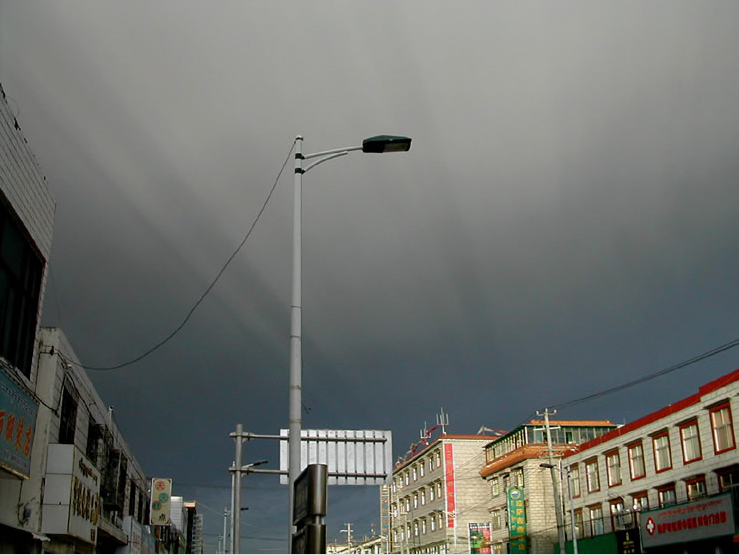Anticrepuscular Rays - Lhasa, Tibet
Anticrepuscular Rays: A Spectacular Atmospheric Phenomenon in Lhasa, Tibet
Lhasa, the capital city of Tibet, is not only known for its rich cultural heritage and breathtaking landscapes but also for the captivating atmospheric optics phenomena that occur in its skies. One such phenomenon that often leaves observers in awe is the occurrence of anticrepuscular rays. These rays, which resemble parallel beams of light interspersed with shadow, create a mesmerizing spectacle as they appear to converge below the horizon.
The image captured by Adolf Cortel in August '05 perfectly showcases the enchanting display of anticrepuscular rays streaming across the main street of Lhasa. Located approximately 500 meters from the iconic Potala Palace, this vantage point offers a unique perspective on this natural phenomenon.
Anticrepuscular rays are often observed during sunrise or sunset when the sun's rays are low on the horizon. They are formed as a result of sunlight passing through gaps in clouds or other obstacles, casting shadows and creating alternating bright and dark bands of light. While these rays may appear to converge, it is actually an optical illusion caused by perspective. In reality, the rays are parallel to each other.
The convergence point of anticrepuscular rays is known as the antisolar point, which is directly opposite the sun. This point lies below the horizon, and its position varies depending on the observer's location and the angle of the sun. In the case of Lhasa, Tibet, the antisolar point would be located in the opposite direction of the setting sun.
One fascinating aspect of anticrepuscular rays is their ability to captivate viewers from different locations. Due to the convergence illusion, these rays can appear to converge towards a single point regardless of where the observer is standing. This creates a sense of wonder and intrigue as people witness this optical phenomenon unfold before their eyes.
While anticrepuscular rays are a captivating sight, they are not exclusive to Lhasa or Tibet. They can be observed in various locations around the world under the right atmospheric conditions. The occurrence of this phenomenon depends on factors such as the presence of clouds or obstacles that can cast shadows, the angle of the sun, and the observer's position.
In addition to anticrepuscular rays, other atmospheric optical phenomena can also be observed in Lhasa, further enhancing the city's reputation as a hotspot for sky gazers. These include the more well-known phenomena such as crepuscular rays (which appear to radiate from the sun), as well as less common occurrences like iridescent clouds and sun halos.
In conclusion, witnessing the spectacle of anticrepuscular rays in Lhasa, Tibet is an experience that is sure to leave a lasting impression on anyone fortunate enough to witness it. The convergence illusion created by these parallel beams of light interspersed with shadow adds an element of mystery and beauty to the already breathtaking surroundings. So, if you ever find yourself in Lhasa during sunrise or sunset, keep your eyes on the horizon and prepare to be mesmerized by the awe-inspiring display of anticrepuscular rays.

Anticrepuscular rays stream across the main street of Lhasa to converge below the horizon.
The rays are parallel bundles of light interspersed with shadow. perspective makes them appear to converge.
This view, about 500m from the Potala Palace, was taken by Adolf Cortel in August '05.
Image ©Adolf Cortel, shown with permission.
Note: this article has been automatically converted from the old site and may not appear as intended. You can find the original article here.
Reference Atmospheric Optics
If you use any of the definitions, information, or data presented on Atmospheric Optics, please copy the link or reference below to properly credit us as the reference source. Thank you!
-
<a href="https://atoptics.co.uk/blog/anticrepuscular-rays-lhasa-tibet/">Anticrepuscular Rays - Lhasa, Tibet </a>
-
"Anticrepuscular Rays - Lhasa, Tibet ". Atmospheric Optics. Accessed on November 26, 2024. https://atoptics.co.uk/blog/anticrepuscular-rays-lhasa-tibet/.
-
"Anticrepuscular Rays - Lhasa, Tibet ". Atmospheric Optics, https://atoptics.co.uk/blog/anticrepuscular-rays-lhasa-tibet/. Accessed 26 November, 2024
-
Anticrepuscular Rays - Lhasa, Tibet . Atmospheric Optics. Retrieved from https://atoptics.co.uk/blog/anticrepuscular-rays-lhasa-tibet/.